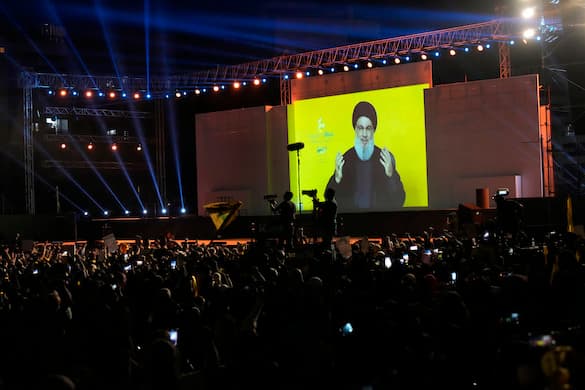Even as Israel Works To Crush Hamas, It Anticipates Wider War With Hezbollah
A top White House adviser, Amos Hochstein, has been visiting Beirut and Jerusalem for weeks in an attempt to convince Hezbollah to move its forces a few miles away from the Israeli border and avert war.

Four months into the war to eliminate Hamas in Gaza, residents of northern Israel are asking, “What about us?”
Lebanon-based Hezbollah and the Israel Defense Force are exchanging fire daily, even as both sides carefully attempt to avoid an escalation into all-out war. Meanwhile, since shortly after October 7 up to 70,000 Israeli citizens have been evacuated from their homes near the Lebanese border.
In the south, “we are on the way to the elimination of Hamas and the release of our hostages,” Prime Minister Netanyahu said Thursday, visiting troops on Mount Hermon. “In the north, we have a simple goal: to return the residents,” he added. “Hezbollah should understand, we will restore security. I hope that they receive this message.”
Since much of Hamas’s military power in Gaza has been degraded that perhaps it is now time for the IDF to move the bulk of the forces to the north, a former commander of the Israeli navy, Vice Admiral Eliezer “Chayni” Marom, told Channel 12 television.
“I’m not seeing that on the ground, but I totally agree with Chayni,” the founder of Alma, Sarit Zehavi, tells the Sun. The northern Israel-based think tank created an uproar in southern Lebanon this week when it published mapped details of fortified tunnels there. Fearing an Israeli attack to destroy these deeply dug facilities, Hezbollah opponents in the region are pushing back against the terror organization.
The IDF and Hezbollah are already exchanging fire daily. A top commander of Hezbollah’s elite Radwan Force, Hassan Saleh, known as “Jaafar,” was reportedly killed Thursday during an air attack on an apartment near Nabatieh in southern Lebanon. He is the 207th Hezbollah operative killed since the start of the war.
Northern Israelis are bracing for a counter attack that is sure to come, as it has following past targeted killings. Yet, civilians are now scarce in the northern Galilee. Residents of Kiryat Shmona, Metula, and other towns and kibbutzim near the border have been evacuated to the south, replaced by IDF troops bracing for a possible invasion of Lebanon.
Unknown Israeli protesters erected roadside signs this week in the north that read, sarcastically, “This road leads to a security strip of southern Lebanon within the territory of the state of Israel. Entry to Israeli citizens is prohibited until security is restored to the northern settlements.”
Even as frustration grows at the IDF’s inability to return security to the north, Israelis know that removing Hezbollah’s threat is a formidable task. The Shiite organization is much better armed than Hamas, which is yet to completely be defeated in Gaza.
“The government has defined the war priorities, which means we need to finish off Hamas first,” a former IDF commander, Brigadier General Amir Avivi, tells the Sun. “In the north, the options are either to widen the current battle to an all-out war, or find a diplomatic solution.”
A top White House adviser, Amos Hochstein, has been visiting Beirut and Jerusalem for weeks in an attempt to convince Hezbollah to move its forces a few miles away from the Israeli border and avert war. French envoys have proposed detailed ideas as well.
Mr. Hochstein is “making a steady progress,” Senator Coons, a close confidant of President Biden, told officials at Jerusalem after visiting Beirut along with Senator Blumenthal. “I think there’s an urgency for both sides in taking this opportunity to de-escalate.”
Many northern Israelis, though, are wary of such diplomatic efforts. Following the 2006 Israel-Hezbollah war, diplomacy took over, to disappointing results.
The United Nations Security Council defined cease-fire terms that limited armed presence in southern Lebanon to a UN force and the Lebanese national army. Hezbollah brazenly defied the UN resolution. It all but took over that area south of Lebanon’s Litani River, where it amassed arms, erected observation points, and dug a maze of deep fortified tunnels designed to store arms, shield troops, and act as a command center.
Over the years the IDF detected and blocked some of the tunnels. Yet, Alma and others have documented a vast sprawl under the rocky terrain, which would be much more difficult to penetrate than the tunnels of sandy Gaza.
Some of these tunnels, as mapped by Alma, have been dug under Christian Maronite and Druze villages, where residents are angry. Other Lebanese are increasingly pushing back against the Shiite terror organization that exposes them to a war they don’t support.
With Gaza’s destruction in full display on Arab television screens, many in Lebanon fear the consequences of a full war with Israel. Western diplomats hope to build on that fear and convince Hezbollah’s chief, Hassan Nasrallah, to pull his forces away from the border in the next few weeks.
If reached, such an arrangement may convince Israeli northerners to return home. Yet, it would merely kick the can down the road. Following October 7, few Israelis would feel completely safe until Hezbollah is defanged in a very painful, but perhaps necessary, war.

